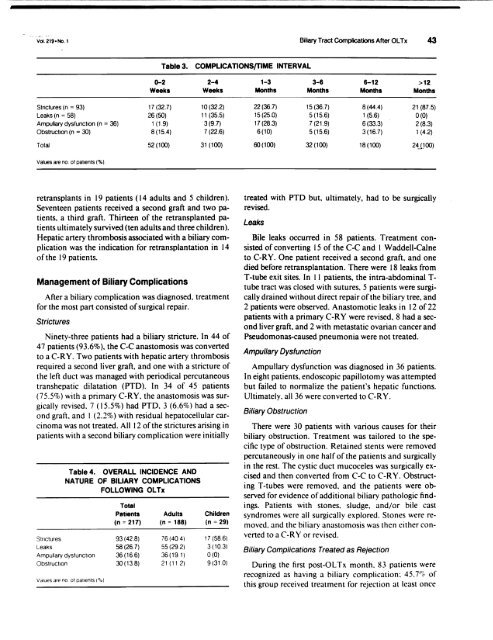Download (869Kb) - D-Scholarship@Pitt - University of Pittsburgh
Download (869Kb) - D-Scholarship@Pitt - University of Pittsburgh
Download (869Kb) - D-Scholarship@Pitt - University of Pittsburgh
Create successful ePaper yourself
Turn your PDF publications into a flip-book with our unique Google optimized e-Paper software.
Vol. 21$0 No. 1 Biliary Tract Complications After OL Tx 43<br />
Table 3. COMPLICATIONSfTlME INTERVAL<br />
0-2 2-4<br />
Weeks Weeks<br />
Strictures (n = 93) 17 (32.7) 10(32.2)<br />
Leaks (n = 58) 26(50) 11 (35.5)<br />
Ampullary dysfunction (n = 36) 1 (1.9) 3(9.7)<br />
Obstruction (n = 30) 8(15.4) 7(22.6)<br />
Total 52(100) 31 (100)<br />
Values are no. <strong>of</strong> patients (%).<br />
retransplants in 19 patients (14 adults and 5 children).<br />
Seventeen patients received a second graft and two patients,<br />
a third graft. Thirteen <strong>of</strong> the retransplanted patients<br />
ultimately survived (ten adults and three children).<br />
Hepatic artery thrombosis associated with a biliary complication<br />
was the indication for retransplantation in 14<br />
<strong>of</strong> the 19 patients.<br />
Management <strong>of</strong> Biliary Complications<br />
After a biliary complication was diagnosed. treatment<br />
for the most part consisted <strong>of</strong> surgical repair.<br />
Strictures<br />
Ninety-three patients had a biliary stricture. In 44 <strong>of</strong><br />
47 patients (93.6%), the C-C anastomosis was converted<br />
to a C-RY. Two patients with hepatic artery thrombosis<br />
required a second liver graft, and one with a stricture <strong>of</strong><br />
the left duct was managed with periodical percutaneous<br />
transhepatic dilatation (PTD). In 34 <strong>of</strong> 45 patients<br />
(75.5%) with a primary C-RY. the anastomosis was surgically<br />
revised. 7 (15.5%) had PTD. 3 (6.6%) had a second<br />
graft. and 1 (2.2%) with residual hepatocellular carcinoma<br />
was not treated. All 12 <strong>of</strong> the strictures arising in<br />
patients with a second biliary complication were initially<br />
Table 4. OVERALL INCIDENCE AND<br />
NATURE OF BILIARY COMPLICATIONS<br />
FOLLOWING OL Tx<br />
Total<br />
Patients Adults<br />
(n = 217) (n = 188)<br />
Strictures 93(428) 76 (404)<br />
Leaks 58(26.7) 55(292)<br />
Ampullary dysfunction 36(16.6) 36(191)<br />
Obstruction 30(13.8) 21 (11 2)<br />
Values are no ot patients ("!o)<br />
Children<br />
(n = 29)<br />
17 (58.6)<br />
3(103)<br />
0(0)<br />
9(31.0)<br />
1-3 3-6 6-12 >12<br />
Months Months Months Months<br />
22(36.7) 15(36.7) 8(44.4) 21 (87.5)<br />
15(25.0) 5(15.6) 1 (5.6) 0(0)<br />
17(28.3) 7 (21.9) 6(33.3) 2(8.3)<br />
6(10) 5(15.6) 3(16.7) 1 (4.2)<br />
60(100) 32(100) 18(100) 24JJoo)<br />
treated with PTD but, ultimately, had to be surgically<br />
revised.<br />
Leaks<br />
Bile leaks occurred in 58 patients. Treatment consisted<br />
<strong>of</strong> converting 15 <strong>of</strong> the C-C and 1 Waddell-Caine<br />
to C-RY. One patient received a second graft, and one<br />
died before retransplantation. There were 18 leaks from<br />
T-tube exit sites. In II patients. the intra-abdominal Ttube<br />
tract was closed with sutures. 5 patients were surgically<br />
drained without direct repair <strong>of</strong> the biliary tree, and<br />
2 patients were observed. Anastomotic leaks in 12 <strong>of</strong>22<br />
patients with a primary C-RY were revised, 8 had a second<br />
liver graft. and 2 with metastatic ovarian cancer and<br />
Pseudomonas-caused pneumonia were not treated.<br />
Ampullary Dysfunction<br />
Ampullary dysfunction was diagnosed in 36 patients.<br />
In eight patients. endoscopic papilIotomy was attempted<br />
but failed to normalize the patient's hepatic functions.<br />
Ultimately, all 36 were converted to C-RY.<br />
Biliary Obstruction<br />
There were 30 patients with various causes for their<br />
biliary obstruction. Treatment was tailored to the specific<br />
type <strong>of</strong> obstruction. Retained stents were removed<br />
percutaneously in one half <strong>of</strong> the patients and surgically<br />
in the rest. The cystic duct mucoceles was surgically excised<br />
and then converted from C-C to C-RY. Obstructing<br />
T-tubes were removed. and the patients were observed<br />
for evidence <strong>of</strong> additional biliary pathologic findings.<br />
Patients with stones. sludge. and/or bile cast<br />
syndromes were all surgically explored. Stones were removed.<br />
and the biliary anastomosis was then either converted<br />
to a C-R Y or revised.<br />
Biliary Complications Treated as Rejection<br />
During the first post-OL Tx month. 83 patients were<br />
recognized as having a biliary complication: 45. r" <strong>of</strong><br />
this group received treatment for rejection at least once















